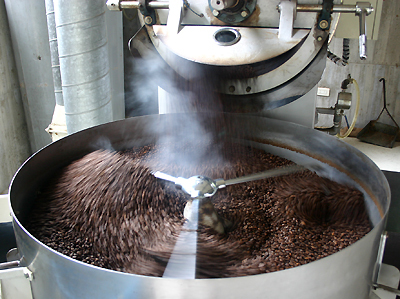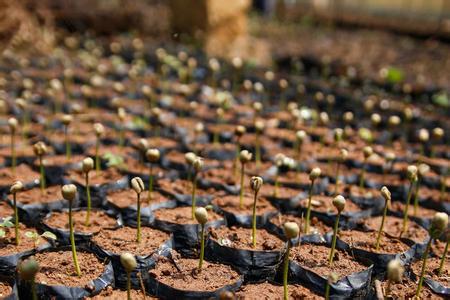Description of acidity and flavor of Sumatra coffee beans A brief introduction to the grinding scale of taste treatment
Description of acidity and flavor of Sumatra coffee beans A brief introduction to the grinding scale of taste treatment
Because coffee beans have four layers of protection-pericarp, pectin, seed shell, silver skin. In the washing method, only the first two layers were removed, and the seed shell and silver coat were preserved and dried in the sun. On the other hand, the wet planing method cuts off the third and fourth layers of protection, that is, the falling body is sunbathed, which is why the raw Sumatran beans are turquoise. Although the wet planing method shortens the drying time, the probability of being unmanned by molds, fungi and yeasts is also greatly increased.
1. Shallow baking (Light)
The most mild fried culture, no fragrance and concentration to speak of, the beans are not yet ripe, with the green taste of raw beans, not suitable for grinding and drinking. It's usually used as an experiment.
2. Deep shallow baking (Cinnamon)
Also known as cinnamon baking, for the general popular degree of frying, leaving a strong sour taste. The color of beans is quite similar to that of cinnamon, so it is also called cinnamon baking and its sour taste is aggravated. It is favored by people in the western United States.
3. Shallow medium baking (Media)
Sumatran tigers have always been the iconic pattern on Sumatran coffee packages. as the smallest tiger of its kind, they have the darkest fur of all tigers, with prominent black stripes and small intervals between stripes. and it's often arranged in pairs, and there are stripes on the front legs. However, there are only about 400-500 Sumatran tigers left in the wild, mainly in five national parks on the island of Indonesia. The endangered Sumatran tiger also sets off the value of Sumatran coffee from the side.
Gold manning is very familiar to many of our friends. But the naming of Golden Manning may not be what many friends think.
First of all, golden manning does not refer to the color of golden yellow, but to large-size coffee beans, that is, coffee beans with more than 19 mesh, which is called golden manning. But as many suppliers find that there is no direct relationship between large size and taste, fewer and fewer people order gold manning.
As for why Manning's old beans are golden, it is because Medan, the coffee transfer station, is very wet (more than 80% of the tide). If you have stored coffee for more than 6 months, the reason why the coffee will return to moisture.
Holding a large cup of Sumatran coffee, a wonderful warmth and mellow smooth feeling arises spontaneously. To me, this feeling is different from any other coffee. After drinking this wonderful brew of coffee for the first time, I feel comfortable and refreshing. In this wonderful experience, I slowly relaxed, completely immersed in this moment, my thoughts drifted far away, and then a drop of coffee unwittingly spilled on my shirt. It's worth it. It's my favorite coffee!
The friction force of coffee beans in the process of shell planing, when the bean body is heated to 30 ℃-60 ℃, is also beneficial to germination and mold growth. And the semi-hard and semi-soft wet raw beans are easily crushed by mechanical force when removing the seed shell, and the beans are easy to crack like a sheep's hoof, which is why there is a high ratio of sheep's hoof beans in Sumatra. However, it is still inconclusive whether the bauhinia bean is good or bad.

Important Notice :
前街咖啡 FrontStreet Coffee has moved to new addredd:
FrontStreet Coffee Address: 315,Donghua East Road,GuangZhou
Tel:020 38364473
- Prev

A brief introduction to the varieties of grinding scale of Tarazhu coffee beans in Costa Rica by the method of describing taste and flavor
Costa Rica Tarazu coffee beans taste description processing method grinding scale varieties Tarazhu as the origin of coffee beans have long been known, coffee harvest season, high-quality beans will receive an additional bonus, and only beans selected after a strict cup, only to Fancy specifications out of the stock. The last time I drank this Tara bead, high altitude SHG grade, is
- Next

A brief introduction to the grinding scale production area of Ethiopian coffee beans by describing the characteristics of taste and flavor
Brief introduction of Ethiopian coffee bean characteristics, taste and flavor description method grinding scale production area Coffee is Ethiopia's most important export cash crop and the main source of Ethiopia's foreign exchange earnings. Ethiopia's coffee exports account for about 3% of the world market, making it the eighth largest coffee exporter in the world. Coffee exports increased steadily from 58000 tons in 1990 to 1995-1996.
Related
- Detailed explanation of Jadeite planting Land in Panamanian Jadeite Manor introduction to the grading system of Jadeite competitive bidding, Red bid, Green bid and Rose Summer
- Story of Coffee planting in Brenka region of Costa Rica Stonehenge Manor anaerobic heavy honey treatment of flavor mouth
- What's on the barrel of Blue Mountain Coffee beans?
- Can American coffee also pull flowers? How to use hot American style to pull out a good-looking pattern?
- Can you make a cold extract with coffee beans? What is the right proportion for cold-extracted coffee formula?
- Indonesian PWN Gold Mandrine Coffee Origin Features Flavor How to Chong? Mandolin coffee is American.
- A brief introduction to the flavor characteristics of Brazilian yellow bourbon coffee beans
- What is the effect of different water quality on the flavor of cold-extracted coffee? What kind of water is best for brewing coffee?
- Why do you think of Rose Summer whenever you mention Panamanian coffee?
- Introduction to the characteristics of authentic blue mountain coffee bean producing areas? What is the CIB Coffee Authority in Jamaica?

